Inductive Power Transfer Subsystem for Integrated Motor Drive
Abstract
1. Introduction
2. Concept of IPT-IMD System
3. MCR Circuit Component Selection
4. Prototype of IPT-IMD System
4.1. MCR Circuit
4.2. Control Method
4.3. IPT-IMD System
5. Experimental Results
- DC parameters (PI = UIII—DC input power, PO = UOIO—DC output power, ηDC = PO/PI—DC/DC efficiency),
- AC parameters (P1AC = —AC input power, P2AC = —AC output power, ηAC = P2AC/P1AC—AC/AC efficiency, where T = —switching period).
6. Conclusions
Author Contributions
Funding
Institutional Review Board Statement
Informed Consent Statement
Conflicts of Interest
References
- Kaźmierkowski, M.P.; Moradewicz, A.J. Unplugged But Connected: Review of Contactless Energy Transfer Systems. IEEE Ind. Electron. Mag. 2012, 6, 47–55. [Google Scholar]
- Jiang, C.; Chau, K.T.; Liu, C.; Lee, C. An Overview of Resonant Circuits for Wireless Power Transfer. Energies 2017, 10, 894. [Google Scholar] [CrossRef]
- Zhang, Z.; Pang, H.; Georgiadis, A.; Cecati, C. Wireless Power Transfer—An Overview. IEEE Trans. Ind. Electron. 2019, 66, 1044–1058. [Google Scholar] [CrossRef]
- RamRakhyani, A.K.; Mirabbasi, S.; Chiao, M. Design and Optimization of Resonance-Based Efficient Wireless Power Delivery Systems for Biomedical Implants. IEEE Trans. Biomed. Circuits Syst. 2011, 5, 48–63. [Google Scholar] [CrossRef]
- Li, Q.; Liang, Y.C. An Inductive Power Transfer System With a High-Q Resonant Tank for Mobile Device Charging. IEEE Trans. Power Electron. 2015, 30, 6203–6212. [Google Scholar] [CrossRef]
- Cannon, B.L.; Hoburg, J.F.; Stancil, D.D.; Goldstein, S.C. Magnetic Resonant Coupling As a Potential Means for Wireless Power Transfer to Multiple Small Receivers. IEEE Trans. Power Electron. 2009, 24, 1819–1825. [Google Scholar] [CrossRef]
- Baszynski, M.; Ruszczyk, A.; Rydygier, P. Wireless energy transfer for industrial applications: Theory, available solutions and perspectives. In Proceedings of the 2016 International Conference on Signals and Electronic Systems (ICSES), Cracow, Poland, 5–7 September 2016. [Google Scholar]
- Jawad, A.M.; Nordin, R.; Gharghan, S.K.; Jawad, H.M.; Ismail, M. Opportunities and Challenges for Near-Field Wireless Power Transfer: A Review. Energies 2017, 10, 1022. [Google Scholar] [CrossRef]
- Houran, M.A.; Yang, X.; Chen, W. Magnetically Coupled Resonance WPT: Review of Compensation Topologies, Resonator Structures with Misalignment, and EMI Diagnostics. Electronics 2018, 7, 296. [Google Scholar] [CrossRef]
- Wang, C.-S.; Stielau, O.H.; Covic, G.A. Design considerations for a contactless electric vehicle battery charger. IEEE Trans. Ind. Electron. 2005, 52, 1308–1314. [Google Scholar] [CrossRef]
- Huh, J.; Lee, S.W.; Cho, G.H.; Rim, C.T. Narrow-Width Inductive Power Transfer System for Online Electrical Vehicles. IEEE Trans. Power Electron. 2011, 26, 3666–3679. [Google Scholar] [CrossRef]
- Han, W.; Chau, K.T.; Zhang, Z. Flexible Induction Heating Using Magnetic Resonant Coupling. IEEE Trans. Ind. Electron. 2017, 64, 1982–1992. [Google Scholar] [CrossRef]
- Jiang, C.; Chau, K.T.; Leung, Y.Y.; Liu, C.; Lee, C.H.T.; Han, W. Design and Analysis of Wireless Ballastless Fluorescent Lighting. IEEE Trans. Ind. Electron. 2019, 66, 4065–4074. [Google Scholar] [CrossRef]
- Hao, H.; Covic, G.A.; Boys, J.T. A Parallel Topology for Inductive Power Transfer Power Supplies. IEEE Trans. Power Electron. 2014, 29, 1140–1151. [Google Scholar] [CrossRef]
- Cheng, C.; Zhou, Z.; Li, W.; Zhu, C.; Deng, Z.; Mi, C.C. A Multi-Load Wireless Power Transfer System With Series-Parallel-Series Compensation. IEEE Trans. Power Electron. 2019, 34, 7126–7130. [Google Scholar] [CrossRef]
- Dang, Z.; Cao, Y.; Abu Qahouq, J.A. Reconfigurable Magnetic Resonance-Coupled Wireless Power Transfer System. IEEE Trans. Power Electron. 2015, 30, 6057–6069. [Google Scholar] [CrossRef]
- Chen, L.; Liu, S.; Zhou, Y.C.; Cui, T.J. An Optimizable Circuit Structure for High-Efficiency Wireless Power Transfer. IEEE Trans. Ind. Electron. 2013, 60, 339–349. [Google Scholar] [CrossRef]
- Ye, Z.; Sun, Y.; Dai, X.; Tang, C.; Wang, Z.; Su, Y. Energy Efficiency Analysis of U-Coil Wireless Power Transfer System. IEEE Trans. Power Electron. 2016, 31, 4809–4817. [Google Scholar] [CrossRef]
- Liao, Z.; Sun, Y.; Ye, Z.; Tang, C.; Wang, P. Resonant Analysis of Magnetic Coupling Wireless Power Transfer Systems. IEEE Trans. Power Electron. 2019, 34, 5513–5523. [Google Scholar] [CrossRef]
- Sato, M.; Yamamoto, G.; Gunji, D.; Imura, T.; Fujimoto, H. Development of Wireless In-Wheel Motor Using Magnetic Resonance Coupling. IEEE Trans. Power Electron. 2016, 31, 5270–5278. [Google Scholar] [CrossRef]
- Jiang, C.; Chau, K.T.; Lee, C.H.T.; Han, W.; Liu, W.; Lam, W.H. A Wireless Servo Motor Drive With Bidirectional Motion Capability. IEEE Trans. Power Electron. 2019, 34, 12001–12010. [Google Scholar] [CrossRef]
- Jiang, C.; Chau, K.T.; Liu, C.; Han, W. Design and Analysis of Wireless Switched Reluctance Motor Drives. IEEE Trans. Ind. Electron. 2019, 66, 245–254. [Google Scholar] [CrossRef]
- Zhang, Z.; Chau, K.T.; Qiu, C.; Liu, C. Energy Encryption for Wireless Power Transfer. IEEE Trans. Power Electron. 2015, 30, 5237–5246. [Google Scholar] [CrossRef]
- Zhang, Y.; Lu, T.; Zhao, Z.; He, F.; Chen, K.; Yuan, L. Selective Wireless Power Transfer to Multiple Loads Using Receivers of Different Resonant Frequencies. IEEE Trans. Power Electron. 2015, 30, 6001–6005. [Google Scholar] [CrossRef]
- Jahns, T.M.; Dai, H. The past, present, and future of power electronics integration technology in motor drives. CPSS Trans. Power Electron. Appl. 2017, 2, 197–216. [Google Scholar] [CrossRef]
- Case Note: White Washdown Cut Saw Motor. Available online: https://library.e.abb.com/public/c44fb8d7e1f442d3b64eb8c7374a6376/9AKK106592_0615_Cut%20Saw%20Motors_WEB.pdf (accessed on 25 February 2021).
- Premium Efficiency Motor Selection and Application Guide. Available online: https://www.energy.gov/sites/prod/files/2014/04/f15/amo_motors_handbook_web.pdf (accessed on 25 February 2021).
- Motor Handbook. Available online: https://www.infineon.com/dgdl/Infineon-motorcontrol_handbook-AdditionalTechnicalInformation-v01_00-EN.pdf?fileId=5546d4626bb628d7016be6a9aa637e69 (accessed on 25 February 2021).
- Kuperman, A. Compensation Capacitors Sizing for Achieving Arbitrary Load-Independent Voltage Gain in Series-Series Compensated Inductive WPT Link operating at Fixed Frequency. IEEE Trans. Power Deliv. 2020, 35, 2737–2739. [Google Scholar] [CrossRef]
- Kaczmarczyk, Z.; Zellner, M. Wireless power transfer with almost constant output voltage at variable load. Prz. Elektrotech. 2020, 96, 26–31. [Google Scholar] [CrossRef]
- Zhang, Y.; Kan, T.; Yan, Z.; Mao, Y.; Wu, Z.; Mi, C.C. Modeling and Analysis of Series-None Compensation for Wireless Power Transfer Systems with a Strong Coupling. IEEE Trans. Power Electron. 2019, 34, 1209–1215. [Google Scholar] [CrossRef]
- Zhang, Y.; Yan, Z.; Kan, T.; Liu, Y.; Mi, C.C. Modelling and analysis of the distortion of strongly-coupled wireless power transfer systems with SS and LCC–LCC compensations. IET Power Electron. 2019, 12, 1321–1328. [Google Scholar] [CrossRef]


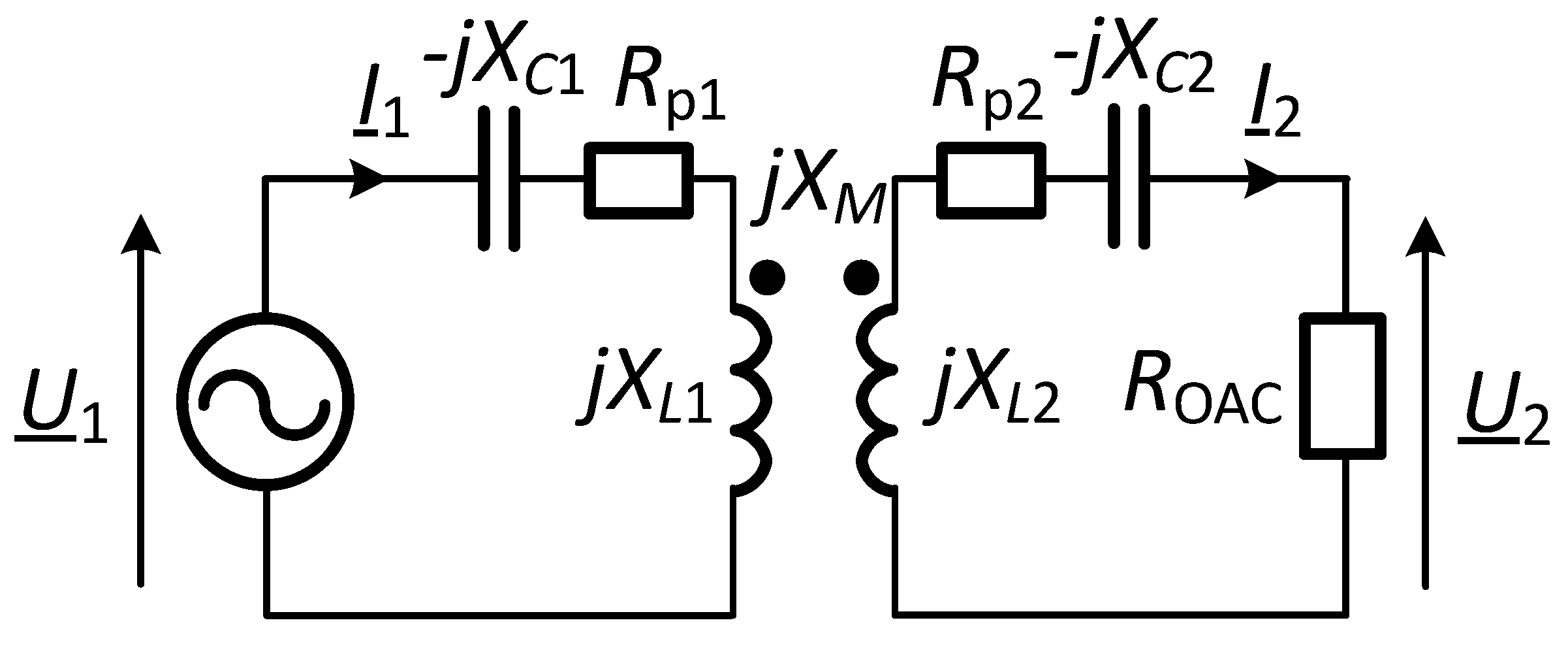


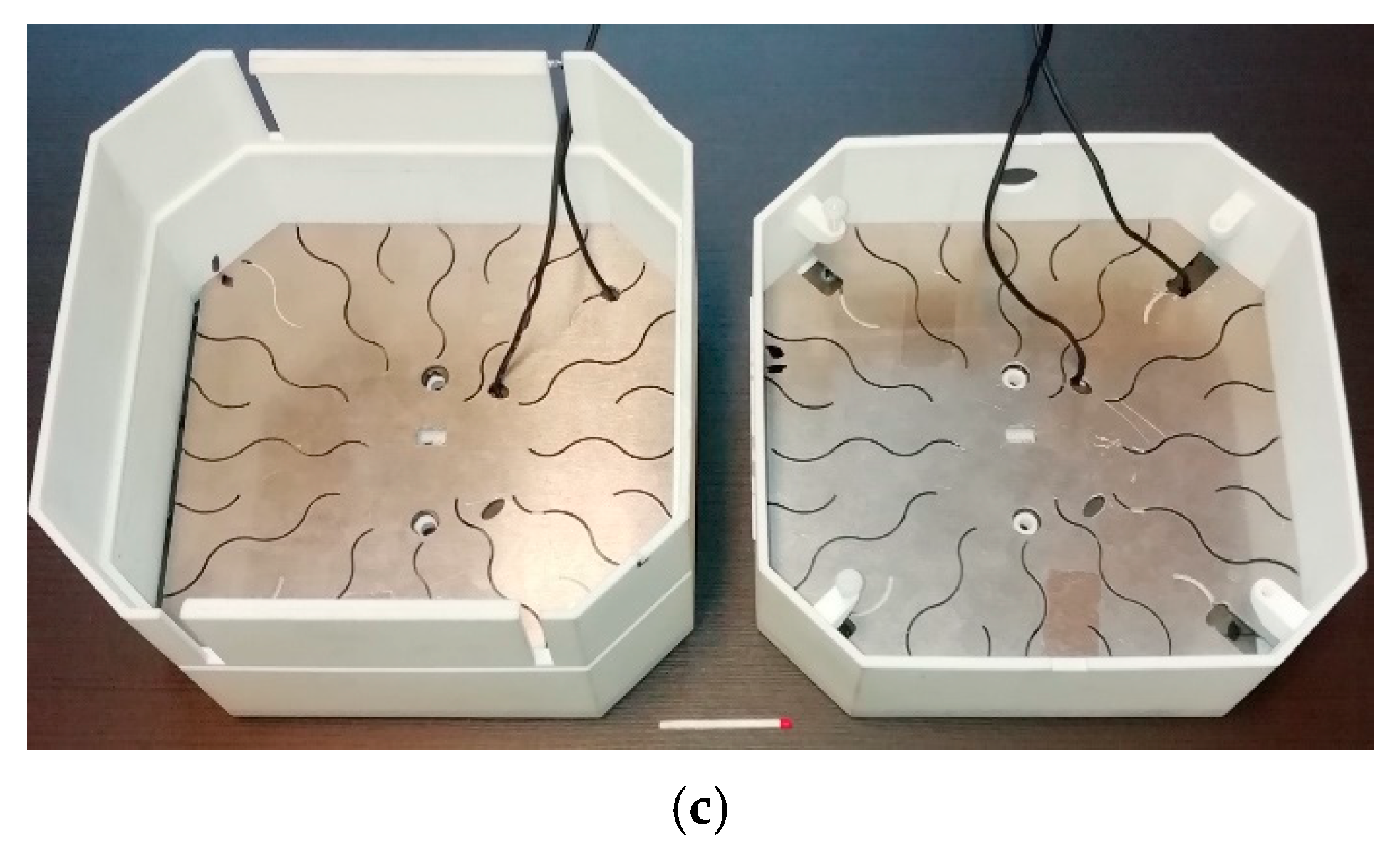
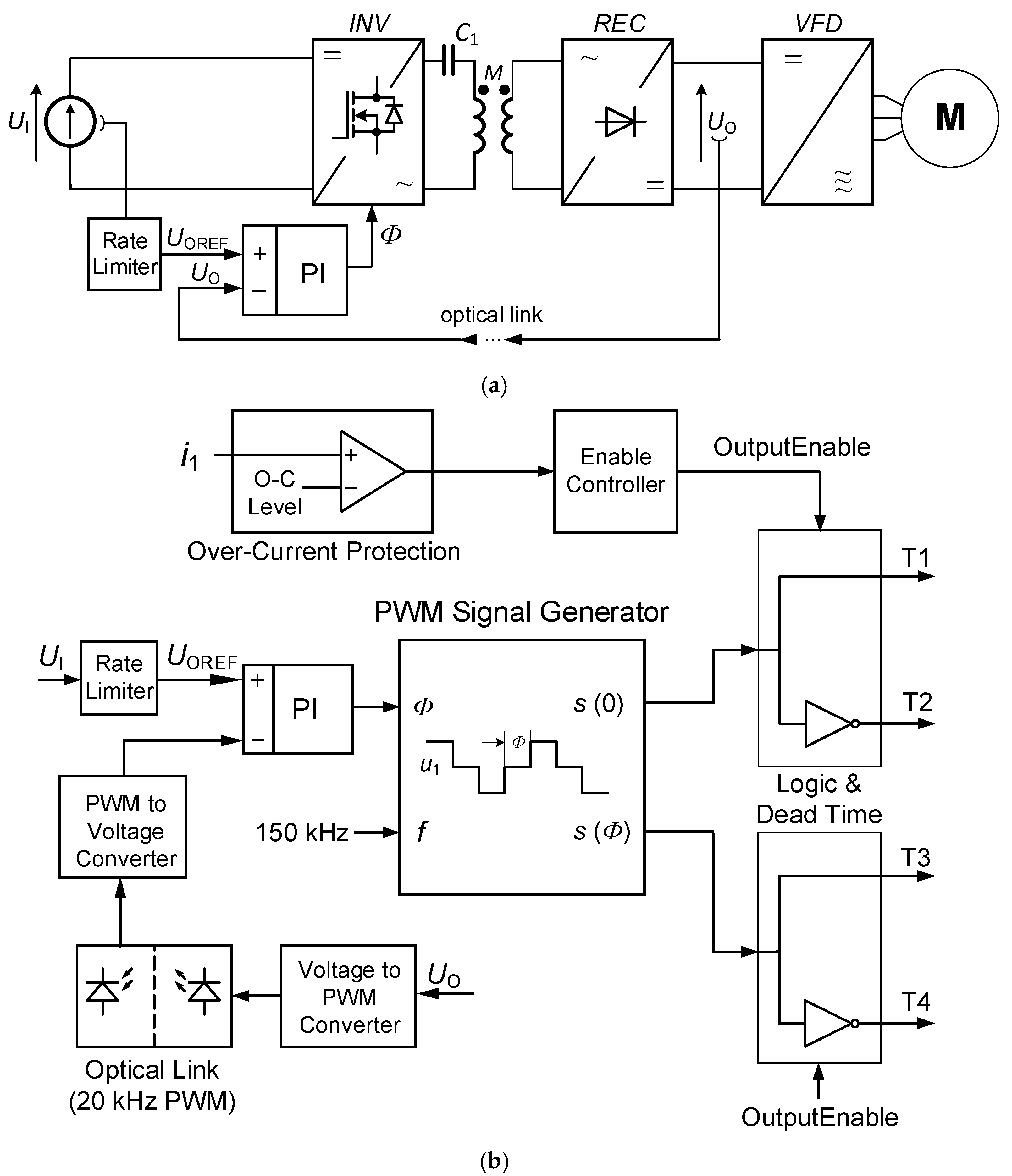
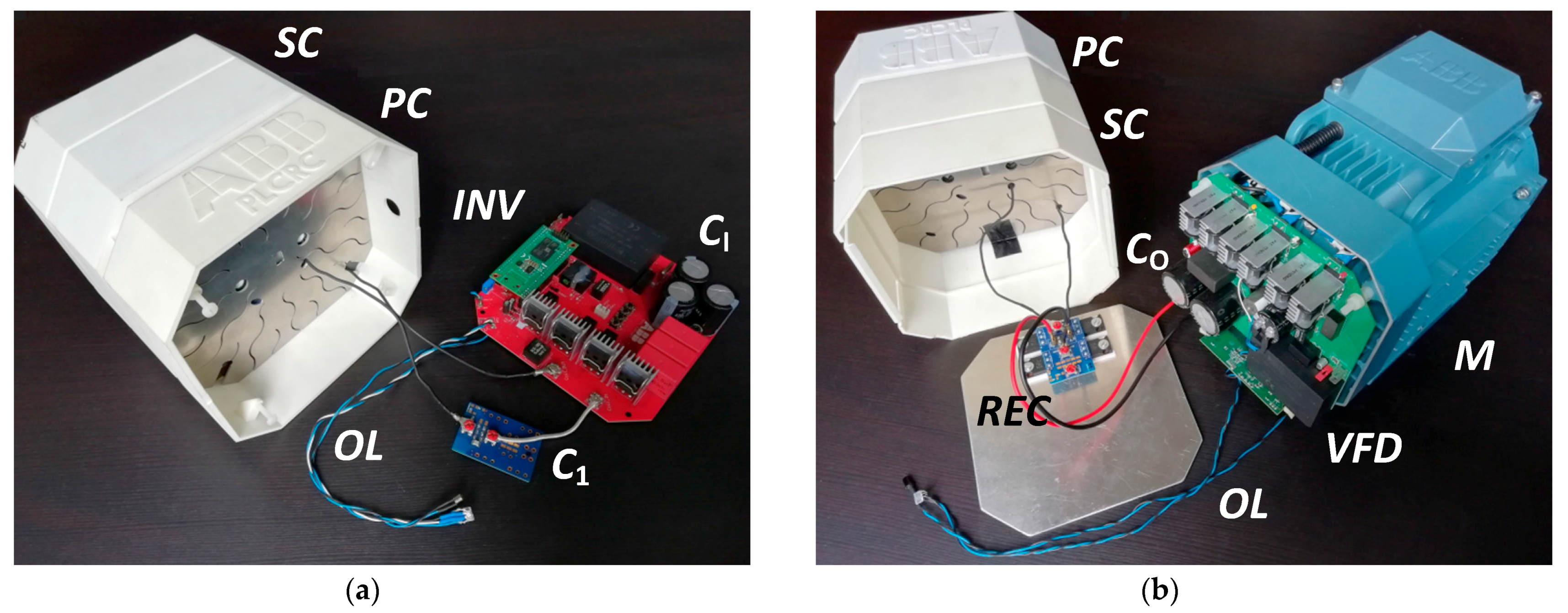


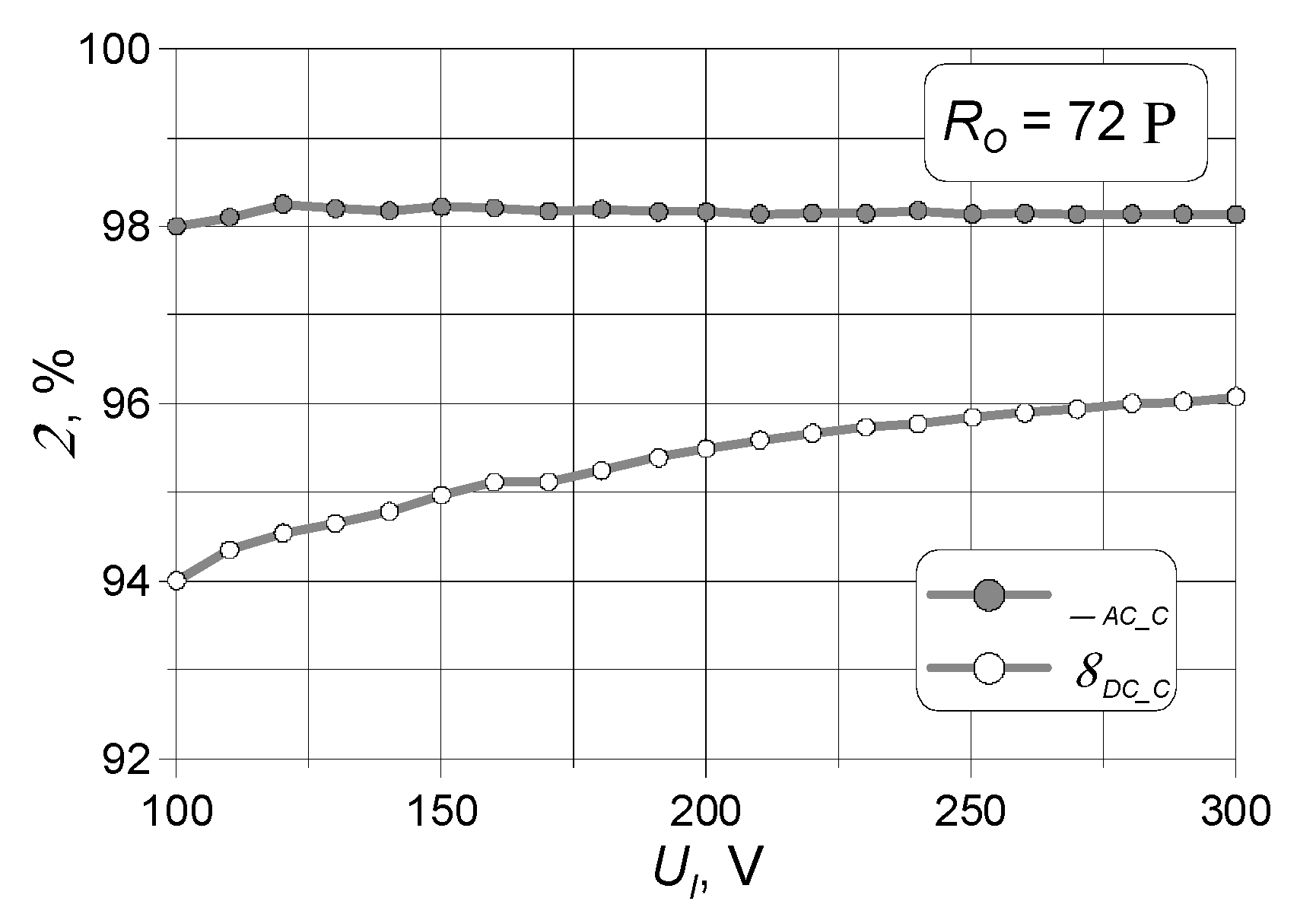

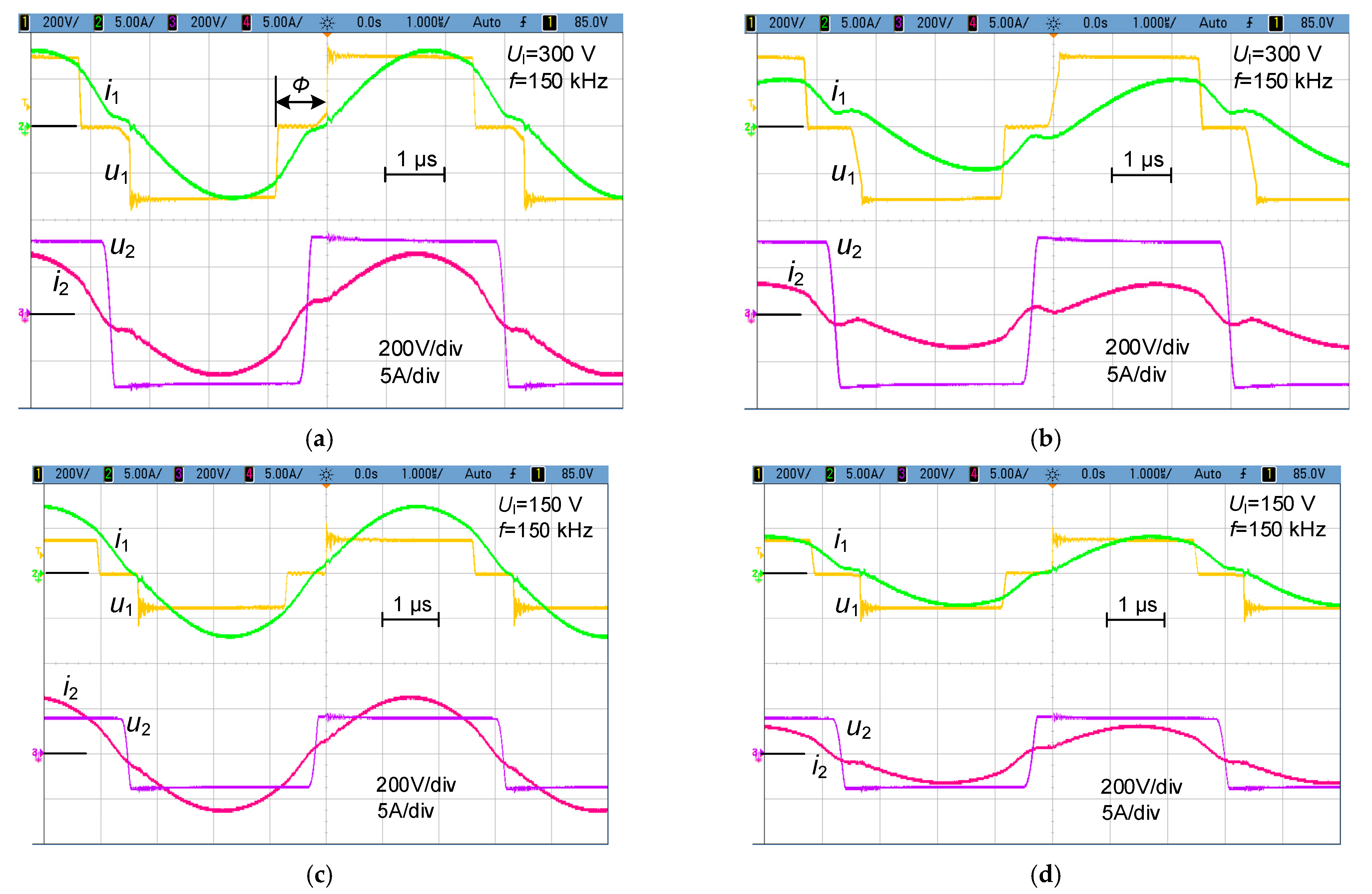
| L1, µH | Q1 | Rp1, Ω | L2, µH | Q2 | Rp2, Ω | k | |
|---|---|---|---|---|---|---|---|
| Coils without shielding | 76.8 | 240 | 0.30 | 76.5 | 247 | 0.29 | 0.65 |
| Coils with magnetic shields | 234 | 305 | 0.72 | 231 | 313 | 0.70 | 0.87 |
| Coils with magnetic shields and aluminum plates | 229 | 218 | 0.99 | 227 | 223 | 0.96 | 0.87 |
| Parameter | Value | Description |
|---|---|---|
| UI | 100–300 V | DC power supply, 300 V/5 A |
| CI | 810 µF | 3 × 270 µF on INV PCB |
| T1–T4 | 650 V/29.5 A | TP65H035WS, GaN FETs |
| C1 | 20.85 nF | MLCC C0G |
| D1–D4 | 650 V/10 A | STPSC20H065 SiC Diodes |
| CO | 940 µF | 2 × 470 µF on VFD PCB |
| RODC | 35–900 Ω | laboratory resistor |
| VFD | 3-phase inverter, 6 × TP65H035WS, GaN FET-based | |
| Motor | 3-phase, 1.5 kW, 1445 rpm, 230/400 V, M3AA090LD4 (delta configuration with nominal voltage of 230 V) | |
Publisher’s Note: MDPI stays neutral with regard to jurisdictional claims in published maps and institutional affiliations. |
© 2021 by the authors. Licensee MDPI, Basel, Switzerland. This article is an open access article distributed under the terms and conditions of the Creative Commons Attribution (CC BY) license (http://creativecommons.org/licenses/by/4.0/).
Share and Cite
Kaczmarczyk, Z.; Kasprzak, M.; Ruszczyk, A.; Sowa, K.; Zimoch, P.; Przybyła, K.; Kierepka, K. Inductive Power Transfer Subsystem for Integrated Motor Drive. Energies 2021, 14, 1412. https://doi.org/10.3390/en14051412
Kaczmarczyk Z, Kasprzak M, Ruszczyk A, Sowa K, Zimoch P, Przybyła K, Kierepka K. Inductive Power Transfer Subsystem for Integrated Motor Drive. Energies. 2021; 14(5):1412. https://doi.org/10.3390/en14051412
Chicago/Turabian StyleKaczmarczyk, Zbigniew, Marcin Kasprzak, Adam Ruszczyk, Kacper Sowa, Piotr Zimoch, Krzysztof Przybyła, and Kamil Kierepka. 2021. "Inductive Power Transfer Subsystem for Integrated Motor Drive" Energies 14, no. 5: 1412. https://doi.org/10.3390/en14051412
APA StyleKaczmarczyk, Z., Kasprzak, M., Ruszczyk, A., Sowa, K., Zimoch, P., Przybyła, K., & Kierepka, K. (2021). Inductive Power Transfer Subsystem for Integrated Motor Drive. Energies, 14(5), 1412. https://doi.org/10.3390/en14051412







